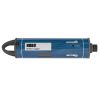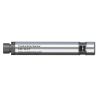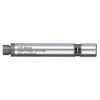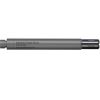HOBO MX800 2-Sensor Adapter
Features
- Turns MX800 logger into multi-parameter sensor instrument
- Can connect sensors directly (MX801), or cables to sensors (MX802)
- Protective housing screws on and off for easy access to sensors
- Free ground shipping
- Expedited repair and warranty service
- Lifetime technical support
- More
This adapter supports the connection of any two sensors to one MX800 data logger- Dissolved Oxygen (W-DO), Conductivity Sensor (W-CT), and CTD sensor (W-CTD-xx).
Sensors can be attached directly to the fully submersible MX801 model, or to the end of a W-series cable that's connected to the direct-read MX802 model. Two sensors of the same type can be attached to monitor at multiple depths. When using a DO with CT or CTD combination, salinity-adjusted DO readings are logged directly without a need to perform post-processing.
The 2-sensor adapter comes with a sensor guard that screws onto the adapter to prevent damage to sensors while allowing ample water flow. Users also have an option to purchase an additional anti-biofouling guard (W-GUARD-2), which extends time between sensor cleanings by reducing fouling of the sensor.
Full Length: 12.3"
Full Length with Anti-Fouling Guard: 12.5"
Diameter: 2.385"
Diameter with Anti-Fouling Guard: 2.5"
- 2-Sensor Adapter
- 2 sets of couplers for attaching the two sensors
- Sensor bracket for holding sensors together
- Sensor guard
- Set screws to lock sensor guard into adapter
- Tapered coupler for attaching adapter to a W-Series direct read cable
In The News
Three Decades of Research at Acton Lake
A multi-disciplinary team at Miami University, Ohio, has been studying the environmental change at Acton Lake for over three decades. Using three different NexSens buoys over this time, the team has an incredible archive of data that is helping build a picture of Acton’s past, present, and future. Until recently, a NexSens CB-50 buoy was used alongside other environmental monitoring at Acton Lake. In May 2025, the Miami team deployed a new XB-200 buoy , future-proofing their ongoing monitoring using real-time buoy systems. Acton Lake, a small hypereutrophic reservoir in southwest Ohio, covers 2.4km² and has a maximum depth of about 8m. The dam was built in 1956, and the lake has a large agricultural watershed.
Read MoreSource Water Monitoring in Albany, New York: Tracing Water Quality throughout Tributaries
Thousands of US cities pull their drinking water from natural source waters like reservoirs, rivers, and streams, making overall watershed health a key consideration for water providers. In Albany, New York, the Albany Department of Water and Water Supply delivers drinking water to over 100,000 residents as well as monitors and manages the larger drinking water supply watershed. Hannah Doherty, Environmental Specialist at the Albany Department of Water and Water Supply , spends her days working with a small team to monitor the drinking supply and the connected water bodies. Doherty explains, “We’re the first to encounter the water that ends up being the drinking water.
Read MoreWildfire Prevention in the Sierra Nevada Region with the Yuba Watershed Institute
Though recent wildfires have sparked new conversations about wildfire management and response, groups like the Yuba Watershed Institute have been monitoring the forests and water resources of the Sierra Nevada region for decades, managing approximately 5,000 acres of land with the Bureau of Land Management (BLM) and about 7,000 acres in private land partnerships. The goal of the Institute is to work with local communities and land agencies to improve watershed and forestry management through informed practices and public outreach. The goals of the Yuba Watershed Institute are three-fold: Improve the ability of fire suppression agencies like the California Department of Forestry and Fire Protection ( CAL FIRE ) and the US Forest Service.
Read More












